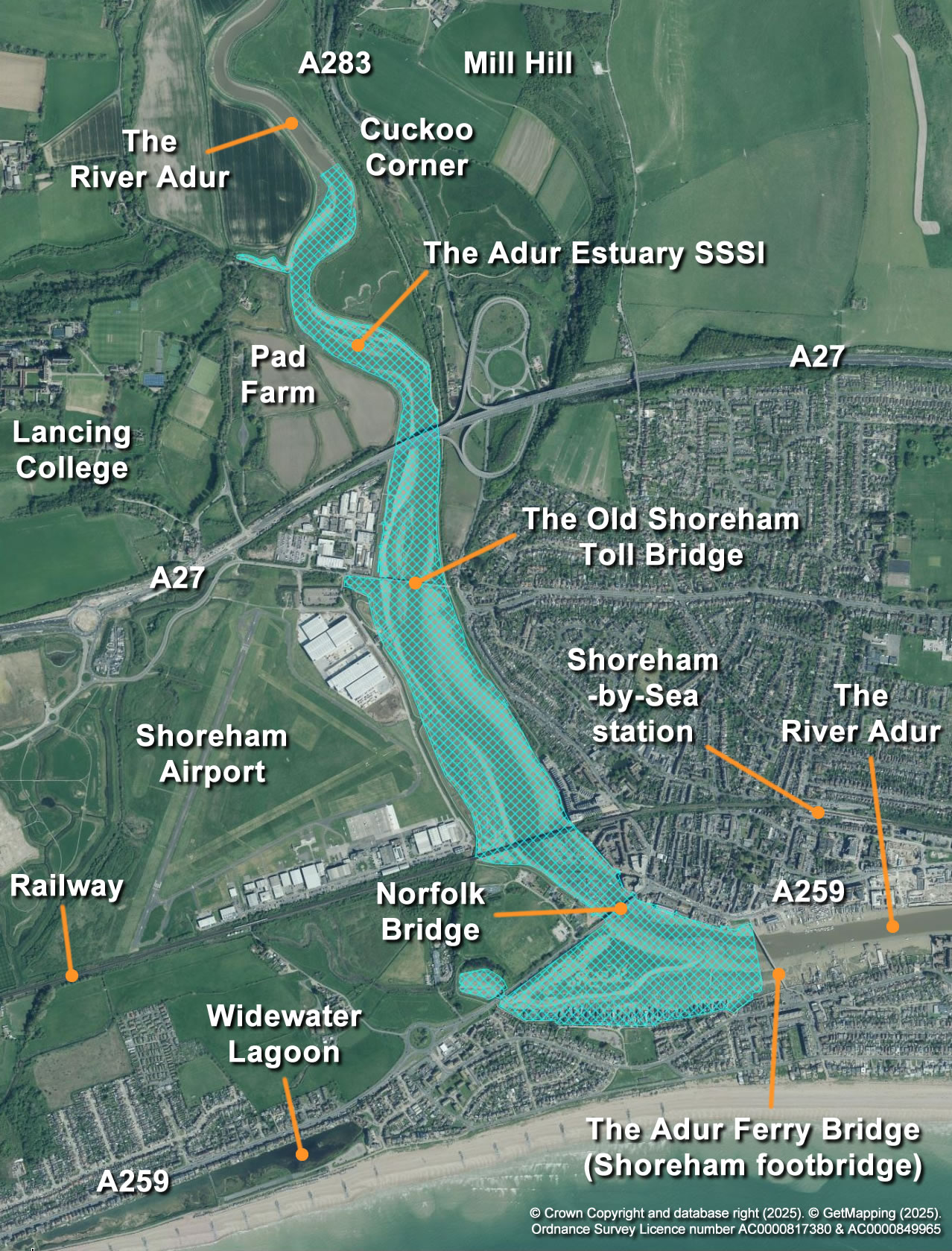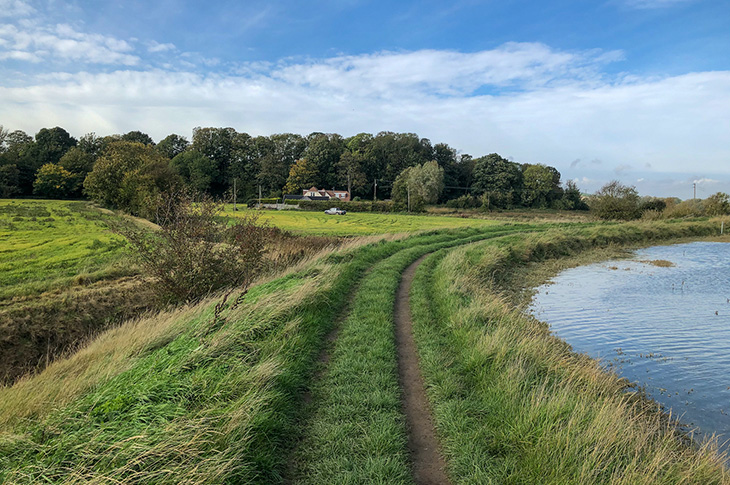Restoring the Adur
We're increasing our focus on helping preserve and improve the Adur Estuary for the benefit of the diverse wildlife that enjoys its special landscape.
In case you missed the news, we have recently adopted a new vision for nature, which sets out our commitments to help protect and restore Adur and Worthing's wonderful natural environment - from the South Downs to the coast.
One of the sites at the centre of the report is the Adur Estuary, a designated Site of Special Scientific Interest that hosts saltmarsh and mudflats - two rare and vital habitats that support a diverse range of migratory bird species.
The site supports small invertebrates, fish and a variety of insects and reptiles. The landscape also hosts a number of plants, including sea purslane, annual seablite, grasswort, sea aster, thrift, common sea lavender and more.
On this webpage you can find out more about our various projects and plans to improve and protect the landscape for future generations.
Photo: River Adur - Adur Estuary

About the Adur Estuary
The Adur Estuary, the southern section of the River Adur and its banks in Shoreham, is a wonderland for West Sussex wildlife such as wading birds and wildfowl.
It's a designated Site of Special Scientific Interest (SSSI) where saltmarsh and mudflats - two crucial coastal habitats - meet, making it one of our district's most important environmental landscapes.
The estuary stretches from Adur Ferry Bridge up to Cuckoo Corner, and visitors can easily explore the site thanks to the walking paths around its perimeter.

Saltmarsh and mudflats are important sanctuaries for birds that thrive where the water joins the land, providing crucial feeding and nesting spots. Many migratory birds, which undertake seasonal journeys between distinct breeding and non-breeding grounds, rely on the estuary to find sufficient food, escape harsh climates and breed, meaning it's crucial that we, the community, create the best conditions for them to thrive.
Birds such as oystercatchers, little egrets, ringed plovers and lapwings explore the estuary at low tide, as they search for worms and shellfish in the mud. At high tide, grey herons, snipe, redshanks and linnets can often be found sheltering in the saltmarsh.
Access to the reserve is restricted so as not to disturb the wildlife and the fragile wetland habitat, but magnificent views across the estuary can be enjoyed from nearby footpaths.
While dogs don't have to be on a lead around the estuary, we ask that they please be kept under close control to ensure that the wildlife and their habitats are undisturbed.
Photo: Images of an oystercatcher, lapwing, redshank and a grey heron

Adur River Recovery project
The Adur River Recovery project is a land manager-led initiative to restore the River Adur, which is one of the biggest rivers in West Sussex.
As a national landscape recovery pilot project supported by the Department for Environment, Food & Rural Affairs (Defra), the project is reconnecting vital nature recovery sites with the help of more than 20 farms and estates, conservation partners and local councils.
As the owner of some of the land, we have committed to continue working in partnership with the project partners to help create a connected landscape that allows nature and our communities to thrive.
As part of the project, we are hoping to create approximately 56 hectares - the equivalent of more than 70 football pitches - of new coastal saltmarsh habitat at Pad Farm, a council-owned site just north of the A27 on the western bank of the River Adur.
The project would see four major weirs strategically removed to improve fish passage and the creation of a 900-metre channel to get around a structure that currently blocks migration of fish. There would also be new woodland and hedgerows created to help wildlife move freely around the landscape to find food, shelter and mates.
The Adur River Recovery project team recently submitted a proposal to the Department for Environment, Food & Rural Affairs for review. We'll let you know when we have an update.
To find out more about the project and its aims, visit:
Photo: Pad Farm, Shoreham

A new future for Old Salts Farm
We are working with Apron Creative, a Shoreham-based community interest company, to transform a disused patch of land in Lancing into a community farm.
Apron Creative is taking a lease on the land next to Old Salts Farm Road, known as Old Salts Farm, to turn it into a regenerative community farm where residents can connect, grow their own food and learn new skills.
The project is expected to take five years to fully develop and Apron Creative will be working with the community to transform the site.
Initial ideas for the site, located to the west of the Adur Estuary, include a market garden and orchard, spaces for wellbeing, therapy sessions and education, an area for a children's forest school, ponds and workshop spaces for craftspeople to share their skills.
The land, which we will retain freehold ownership of, was previously home to Riverside Equestrian Centre, but has been empty since the lease came to an end in 2024. Since then, we have carried out an expression of interest process to identify a new tenant that can bring the site back into use for the benefit of the community.
We recently held a community information session at Seaside Primary School for residents to find out more about the site. Our neighbourhood team and the founder of Apron Creative, Lis Long, explained the selection process, shared the vision for the site, outlined how residents can get involved, and answered questions.
To find out more about the plans for the site, visit:
Apron Creative has launched a crowdfunder campaign to raise funds for the project. Please visit its website to donate or find out more about community sessions, workshops, events, and volunteering opportunities at its Buckingham Park community garden.
Image: Apron Creative's initial plan for Old Salts Farm in Lancing

Improving signage around the Adur Estuary for dog walkers
We recently asked for people's views on a proposal that the public paths on either side of the Adur Estuary should become a dogs-on-lead area.
The proposal, which was put forward by members of the community, looked to better protect the estuary, its diverse habitats and the endangered wildlife it supports, from the small number of dogs that leave the public paths.
While the majority of dogs that enjoy the estuary are perfectly well controlled by their owners, some unfortunately leave the paths and disturb the migratory birds that rely on the landscape's rare habitat to survive.
Following a public consultation, which highlighted the strong feelings both in favour and against the proposal, we decided not to introduce a dogs-on-lead order across the Site of Special Scientific Interest (SSSI) at this stage.
Instead, we'll be teaming up with the Friends of Adur SSSI to improve the signage along the paths, which we hope will increase awareness of the impact dogs can have on the estuary and the wildlife that relies on it.
We would like to thank the Friends of Adur SSSI for their support with this project, which will hopefully allow wildlife along the estuary to settle and thrive.
Photo: A dog walking along a rural public path

The Friends of Adur SSSI
We are fortunate to have the support of the Friends of Adur SSSI, which is a group of volunteers working to help make the Adur Estuary the best it can be for wildlife and our communities.
Its vision is to engage the community with the SSSI and spread awareness of its value to wildlife and the local population. Above all, it aims to encourage responsible use of the estuary, so it's in the best health for future generations.
Friends of Adur SSSI also hosts a number of events and activities throughout the year to showcase the estuary's beauty and encourage people to find out more about the wildlife and habitat it supports.
The volunteer group works alongside nature partners such as the Adur River Recovery project, Natural England, the Royal Society for the Protection of Birds (RSPB), and Shoreham District Ornithological Society to best represent and protect the estuary.
We look forward to working with the group to create new dog-related signage along the estuary and deliver approximately 56 hectares of new coastal saltmarsh habitat at Pad Farm, which we're hoping will be delivered through the Adur River Recovery project.
Friends of Adur SSSI is always looking for new members and sponsors, so be sure to visit their website if you would like to find out more:
Water quality along the River Adur
We take samples of water from the River Adur to check for the presence of potentially harmful bacteria, such as Escherichia coli (E.coli).
Samples are collected monthly from the Old Shoreham Toll Bridge, the Adur Ferry Bridge, Norfolk Bridge and from the channel to the west of Adur Recreation Ground.
We monitor the quality of the transitional water because this part of the river is used by the public for leisure activities and water sports. It's also important that the River Adur is clean to ensure it can best support the wildlife that uses it for habitat and food.
These sampling sites all have public access bridges which allows water to be collected without unsettling the riverbed, even at low tide. This ensures the sample does not contain too much sediment or mud.
To view our water quality results for the River Adur, see:
Photo: The River Adur pictured from Shoreham

How can I help look after the Adur Estuary?
You can help protect the Adur Estuary by responsibly disposing of litter, sticking to designated paths to protect sensitive habitats, keeping dogs under control, and avoiding disturbing wildlife.
You can also get involved with local groups, like the Friends of Adur SSSI, the Ouse & Adur Rivers Trust, or the Adur River Recovery project, by volunteering, donating, or simply spreading awareness of their causes.
Links to our partners and projects
Huge thanks to all our partners, community groups and volunteers who help make the River Adur and the estuary a better place for everyone and nature to enjoy:
- Adur River Recovery website
- Ouse & Adur Rivers Trust website
- Friends of Adur SSSI website
- Apron Creative website
- Shoreham District Ornithological Society website
- Royal Society for the Protection of Birds (RSPB) website
- Department for Environment, Food & Rural Affairs (Defra) - on the GOV.UK website
- The Environment Agency - on the GOV.UK website
Page last updated: 21 November 2025

